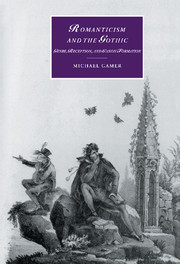Book contents
- Frontmatter
- Contents
- Acknowledgments
- List of abbreviations
- A note on the text
- Introduction: Romanticism's “pageantry of fear”
- 1 Gothic, reception, and production
- 2 Gothic and its contexts
- 3 “Gross and violent stimulants”: producing Lyrical Ballads 1798 and 1800
- 4 National supernaturalism: Joanna Baillie, Germany, and the gothic drama
- 5 “To foist thy stale romance”: Scott, antiquarianism, and authorship
- Notes
- Index
- CAMBRIDGE STUDIES IN ROMANTICISM
1 - Gothic, reception, and production
Published online by Cambridge University Press: 22 September 2009
- Frontmatter
- Contents
- Acknowledgments
- List of abbreviations
- A note on the text
- Introduction: Romanticism's “pageantry of fear”
- 1 Gothic, reception, and production
- 2 Gothic and its contexts
- 3 “Gross and violent stimulants”: producing Lyrical Ballads 1798 and 1800
- 4 National supernaturalism: Joanna Baillie, Germany, and the gothic drama
- 5 “To foist thy stale romance”: Scott, antiquarianism, and authorship
- Notes
- Index
- CAMBRIDGE STUDIES IN ROMANTICISM
Summary
In looking at the Gothic Fiction of the 1790s, it is important to keep in mind that this was not a strange outcropping of one particular literary genre, but a form into which a huge variety of cultural influences, from Shakespeare to ‘Ossian’, from medievalism to Celtic nationalism, flowed. And one concomitant of this is that most of the major writers of the period 1770 to 1820 – which is to say, most of the major poets of that period – were strongly affected by Gothic in one form or another. And this was not merely a passive reception of influence: Blake, Coleridge, Shelley, Byron, and Keats all played a part in shaping the Gothic, in articulating a set of images of terror which were to exercise a potent influence over later literary history.
(David Punter, The Literature of Terror)At the rare times when literary historians have confronted the question of romantic poetry's relation to gothic fiction and drama, they usually have described it in the language of influence. Though few in number, scholars since John Beer and Eino Railo have noted late-eighteenth- and early-nineteenth-century poets' fondness for gothic authors and conventions. Recent monographs on the gothic – including studies by Steven Bruhm, Jeffrey Cox, Judith Halberstam, Kilgour, Miles, José B. Monleón, David Richter, and Williams – have remarked at least in passing upon the close thematic and chronological proximities of gothic fiction and the poetry of the same decades.
- Type
- Chapter
- Information
- Romanticism and the GothicGenre, Reception, and Canon Formation, pp. 27 - 47Publisher: Cambridge University PressPrint publication year: 2000



